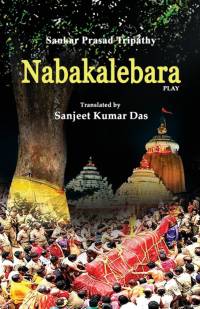Über Nabakalebara
One of the renowned playwrights of Odisha, Shankar Prasad Tripathy's Nabakalebara is a historical play. It's so vast that all other cultures can confluence in its perennial streams of human values. Its universality and all-embracing approach appeal to people worldwide forever. 'Why we celebrate Nabakalebar' is foregrounded and well-substantiated thematically in the play. The ideas mapped in this work of art can be critically analyzed as follows: (1) the human desire for territorial expansion as in the character of Akbar, the Great and Mukunda Deva, to some extent because of his alliance with Rudranarayan of Bhurishrestha of the 'Land of Banga' to fight against Suleiman Karrani, the King of 'Gouda Land' (2) The primal instinct of love obliterating social boundaries persists between Kalapahada, commander-in-Chief of the combined force of the King of Kalinga and Bhurishrestha and Gulnaz, the daughter of Suleiman Karrani, of 'Land of Gouda' (3) the traumatic experiences of the protagonist lacking spiritual bliss, after fulfilling his love-marriage with Gulnaz and his subsequent revengeful acts against the deities and the people of Odisha, (4) Reinstallation of Brahmas in the idols and their mounting on the bejewelled throne (Ratnasinghashana) at the Jagannatha Temple, Puri reaffirms and rejuvenates faith in the people again that Brahma (Supreme Soul) is One and only One, eternal and can't be destroyed by anybody and anything in the material world. That's why, Kalapahada, at last broke apart, while trying to burn in fire. Jagannatha is the root cause of everything happening in the world. His blessing helps the people move forward in day-to-day life.The Nabakalebara festival is deeply rooted in the psyches of the people who love the Jagannatha cult. It's similar to the demise and rebirth of life in all religions of the world. It happens every twelve years. Anything that comes out of this earth is subject to decay and change. The external bodily forms of the idols are buried under the soil in Koilibaikuntha, Puri, whereas the Brahma remains intact and installed again in the newly made wooden idols. There is one and only one Brahma in the world. That can't be drowned in water, burnt in fire; that can't be severed or split and will remain unaltered for ages. Once the idols are half-burnt and thrown into the sea, they can't be worshipped. The new idols (Darubrahmas) are installed and mounted on the (Ratnasinghasana) bejewelled throne at Jagannatha Temple, Puri. Selection of Darus as per the order of Goddess Mangala, and its felling after chanting the mantras, and performing Yajna, transferring the Darus loaded on bullock carts to Jagannatha Temple, Puri, and replacing older idols by the newer ones, and lastly the installing Brahmas in the newer Darus are the processes related to Nabakalebara ceremony.
Mehr anzeigen

